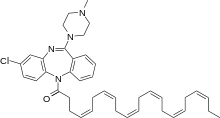DHA-clozapine
 | |
| Clinical data | |
|---|---|
| Trade names | Clozaprexin |
| Identifiers | |
|
225916-82-5 | |
| PubChem | CID 9852332 |
| ChemSpider |
8028044 |
| Synonyms | Docosahexaenoyl clozapine |
| Chemical data | |
| Formula | C40H49ClN4O |
| 637.30 g/mol | |
|
SMILES
| |
| |
| | |
DHA-clozapine (trade name Clozaprexin) is an atypical antipsychotic that has been developed by Protarga.[1] The drug has been created by the association of the fatty acid docosahexaenoic acid (DHA) with clozapine. The advantages of this drug are that until the DHA and clozapine are separated, the drug is inactive; once it penetrates the blood brain barrier, the DHA and clozapine are freed from each other slowly by enzymatic activity and therefore more clozapine is liberated where it is needed, rendering the drug much more potent, actively longer in duration, and therefore requiring a much lower dosage, which results in fewer side effects.[2] The drug is not yet available.
Motives for creation
In controlled studies, Clozapine was more effective than competing atypical antipsychotics. Clozapine also lowers patients' risk of suicide. Both of these qualities distinguish it from almost all other atypicals. But clozapine also causes significant amounts of low blood pressure, body weight increases, type II diabetes, and agranulocytosis. It was believed that, insofar as the above side effects are caused by the presence of active clozapine outside the brain, molecular attachment to DHA might reduce their frequency by passivating the form in which the drug exists prior to crossing the blood brain barrier.[2]
References
- ↑ Preclinical Data on Novel Antipsychotic Agent, Harvard Medical School Investigators Report
- ↑ 2.0 2.1 Baldessarini, R.; Campbell, A.; Webb, N. L.; Swindell, C. S.; Flood, J. G.; Shashoua, V. E.; Kula, N. S.; Hemamalini, S.; Bradley, M. O. (2001). "Fatty Acid Derivatives of Clozapine Prolonged Antidopaminergic Activity of Docosahexaenoylclozapine in the Rat". Neuropsychopharmacology 24 (1): 55–65. doi:10.1016/S0893-133X(00)00173-1. PMID 11106876.